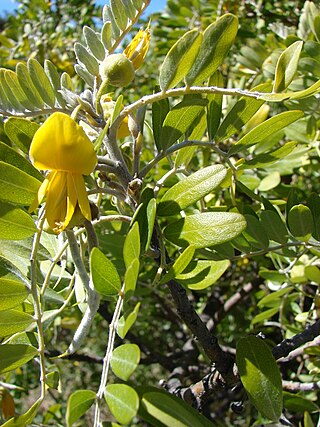In finance, a credit derivative refers to any one of "various instruments and techniques designed to separate and then transfer the credit risk" or the risk of an event of default of a corporate or sovereign borrower, transferring it to an entity other than the lender or debtholder.

Ergoline is a chemical compound whose structural skeleton is contained in a variety of alkaloids, referred to as ergoline derivatives or ergoline alkaloids. Ergoline alkaloids, one being ergine, were initially characterized in ergot. Some of these are implicated in the condition ergotism, which can take a convulsive form or a gangrenous form. Even so, many ergoline alkaloids have been found to be clinically useful. Annual world production of ergot alkaloids has been estimated at 5,000–8,000 kg of all ergopeptines and 10,000–15,000 kg of lysergic acid, used primarily in the manufacture of semi-synthetic derivatives.

Sophora is a genus of about 45 species of small trees and shrubs in the pea family Fabaceae. The species have a pantropical distribution. The generic name is derived from sophera, an Arabic name for a pea-flowered tree.

Sofalcone (INN) is an oral gastrointestinal medication used in Japan. It is a synthetic analog of sophoradin, a type of natural phenol found in Sophora tonkinensis, an herb used in traditional Chinese medicine.

Matrine is an alkaloid found in plants from the genus Sophora. It has a variety of pharmacological effects, including anti-cancer effects, as well as κ-opioid and μ-opioid receptor agonism.
S. tonkinensis may refer to:

Sophoradin is an isoprenyl chalconoid, a type of polyphenolic compound, found in Sophora tonkinensis, an herb used in traditional Chinese medicine.

8-Prenylnaringenin (8-PN; also known as flavaprenin, (S)-8-dimethylallylnaringenin, hopein, or sophoraflavanone B) is a prenylflavonoid phytoestrogen. It is reported to be the most estrogenic phytoestrogen known. The compound is equipotent at the two forms of estrogen receptors, ERα and ERβ, and it acts as a full agonist of ERα. Its effects are similar to those of estradiol, but it is considerably less potent in comparison.

QUCHIC is a designer drug offered by online vendors as a cannabimimetic agent, and was first detected being sold in synthetic cannabis products in Japan in early 2013, and subsequently also in New Zealand. The structure of QUCHIC appears to use an understanding of structure-activity relationships within the indole class of cannabimimetics, although its design origins are unclear. QUCHIC, along with QUPIC, represents a structurally unique synthetic cannabinoid chemotype since it contains an ester linker at the indole 3-position rather than the precedented ketone of JWH-018 and its analogues, or the amide of SDB-001 and its analogues.

ADBICA (also known as ADB-PICA) is a designer drug identified in synthetic cannabis blends in Japan in 2013. ADBICA had not previously been reported in the scientific literature prior to its sale as a component of synthetic cannabis blends. ADBICA features a carboxamide group at the 3-indole position, like SDB-001 and STS-135. The stereochemistry of the tert-butyl side-chain in the product is unresolved, though in a large series of indazole derivatives structurally similar to ADBICA that are disclosed in Pfizer patent WO 2009/106980, activity resides exclusively in the (S) enantiomers. ADBICA is a potent agonist of the CB1 receptor and CB2 receptor with an EC50 value of 0.69 nM and 1.8 nM respectively.

THJ-2201 is an indazole-based synthetic cannabinoid that presumably acts as a potent agonist of the CB1 receptor and has been sold online as a designer drug.

FUBIMINA is a synthetic cannabinoid that is the benzimidazole analog of AM-2201 and has been used as an active ingredient in synthetic cannabis products. It was first identified in Japan in 2013, alongside MEPIRAPIM.

PTI-2 (SGT-49) is an indole-based synthetic cannabinoid. It is one of few synthetic cannabinoids containing a thiazole group and is closely related to PTI-1. These compounds may be viewed as simplified analogues of indole-3-heterocycle compounds originally developed by Organon and subsequently further researched by Merck.

PTI-1 (SGT-48) is an indole-based synthetic cannabinoid. It is one of few synthetic cannabinoids containing a thiazole group and is closely related to PTI-2. These compounds may be viewed as simplified analogues of indole-3-heterocycle compounds originally developed by Organon and subsequently further researched by Merck.

4-Methylbuphedrone, is a stimulant drug of the cathinone class that has been sold online as a designer drug.

NE-CHMIMO (CHM-018) is an indole-based synthetic cannabinoid that is presumed to be a potent agonist of the CB1 receptor and has been sold online as a designer drug. NE-CHMIMO is the 1-cyclohexylmethyl (instead of 1-pentyl) analogue of the first-generation synthetic cannabinoid JWH-018. The corresponding cyclohexylmethyl derivative of JWH-081 had also been reported several months earlier.

Methylstenbolone, known by the nicknames M-Sten, Methyl-Sten, and Ultradrol, is a synthetic and orally active anabolic–androgenic steroid (AAS) and a 17α-methylated derivative of dihydrotestosterone (DHT) which was never introduced for medical use. It is a designer steroid and has been sold via the internet marketed as a dietary/nutritional supplement.

Dimethyltrienolone is a synthetic, orally active, and extremely potent anabolic–androgenic steroid (AAS) and 17α-alkylated 19-nortestosterone (nandrolone) derivative which was never marketed for medical use. It has among the highest known affinity of any AAS for the androgen receptors, and has been said to be perhaps the most potent AAS to have ever been developed.

Cannabidiol-dimethylheptyl (CBD-DMH or DMH-CBD) is a synthetic homologue of cannabidiol where the pentyl chain has been replaced by a dimethylheptyl chain. Several isomers of this compound are known. The most commonly used isomer in research is (−)-CBD-DMH, which has the same stereochemistry as natural cannabidiol, and a 1,1-dimethylheptyl side chain. This compound is not psychoactive and acts primarily as an anandamide reuptake inhibitor, but is more potent than cannabidiol as an anticonvulsant and has around the same potency as an antiinflammatory. Unexpectedly the “unnatural” enantiomer (+)-CBD-DMH, which has reversed stereochemistry from cannabidiol, was found to be a directly acting cannabinoid receptor agonist with a Ki of 17.4nM at CB1 and 211nM at CB2, and produces typical cannabinoid effects in animal studies, as does its 7-OH derivative.

α-PCyP is a stimulant drug of the cathinone class that has been sold online as a designer drug. In a series of alpha-substituted pyrrolidinyl cathinone derivatives developed in 2015, the alpha-cyclopentyl derivative was found to have around the same potency in vitro as an inhibitor of the dopamine transporter as the alpha-propyl derivative α-PVP, while the alpha-cyclohexyl derivative α-PCyP was around twice as strong.

















